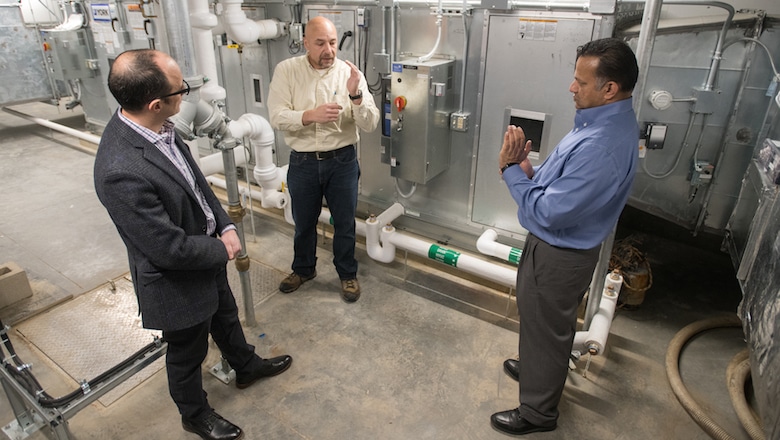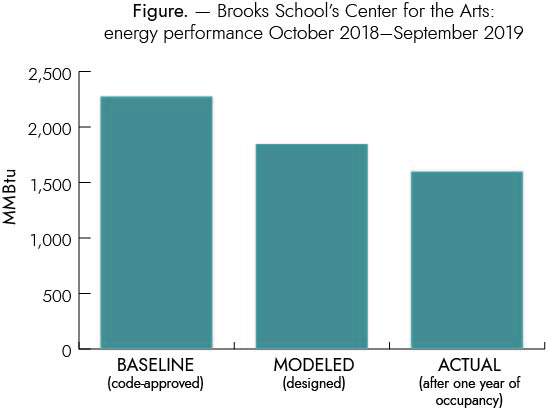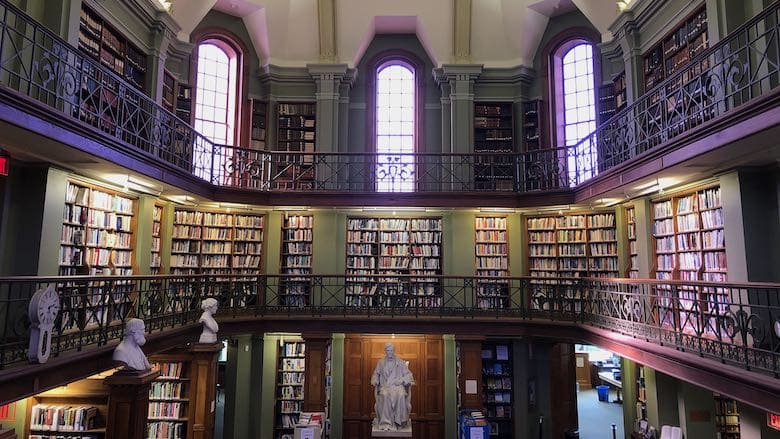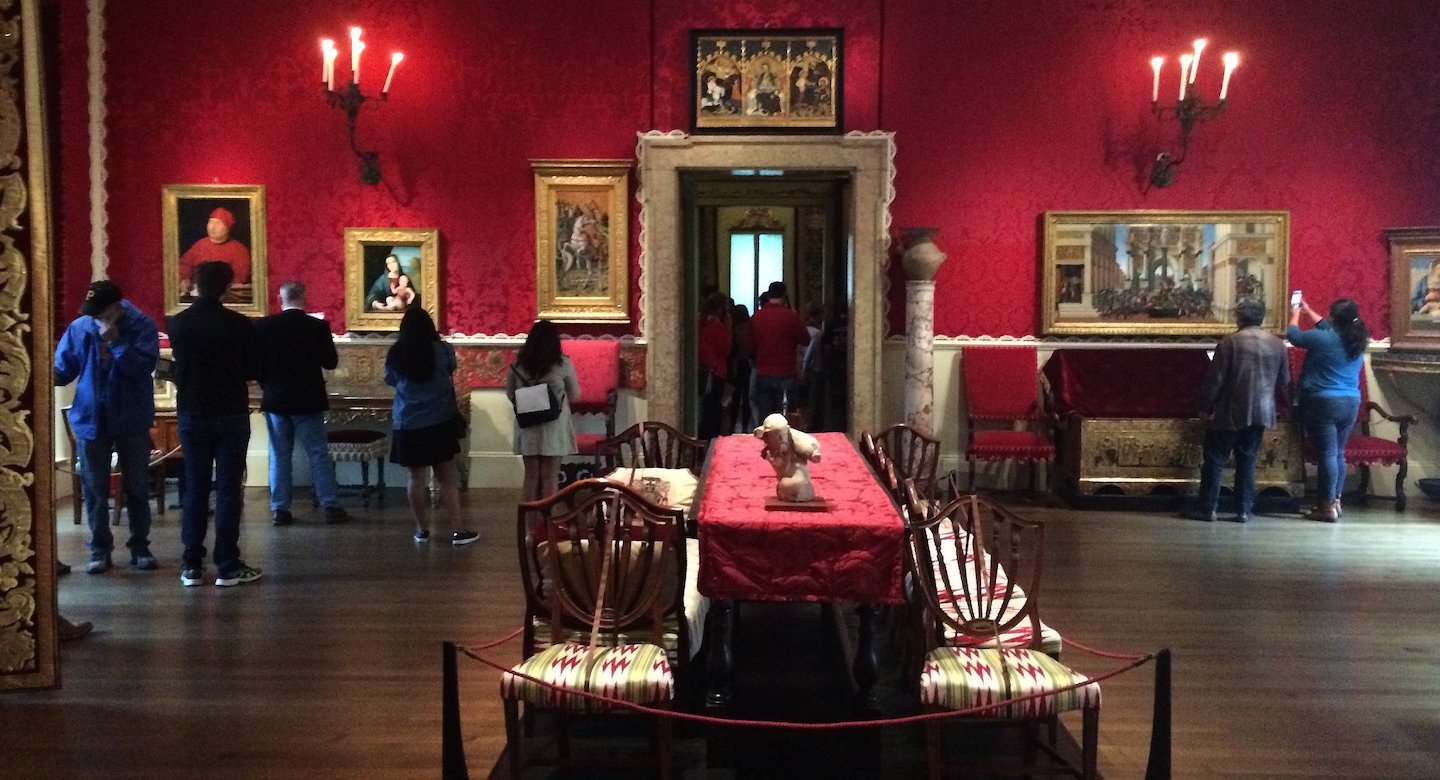Value management: how constructing Brooks School’s Center for the Arts innovated collaboration in engineering design
In 2016, in partnership with Consigli Construction Co., Brooks School began planning its brand-new Center for the Arts and right from the beginning involved GreenerU in all mechanical and electrical aspects of the design, including an enabling project that included a steam system relocation and a chilled water plant for the new Arts Center. The result is a beautiful new arts space that delights students and facility managers alike.

“It never worked right from day one.”
Have you ever heard this complaint? Or maybe you’re the one who’s made it?
We get it. New buildings are big, complicated endeavors. It costs tens of millions of dollars to construct a new library or athletic center. And fundraising for these buildings is often from donors who might be looking to leave a legacy in the form of a cornerstone or a brick, not ductwork or pipes.
Often when construction ramps up, so creeps up the price tag. Building costs can create a series of sticker shock waves, as problems and weather and delays scramble the best-laid plans.
This is where “value engineering” plays a part—when an owner or general contractor is looking for ways to recover some costs by eliminating some aspects of the project that might yield short-term savings.
But thinking short term can bite you in the end.
Brooks School on confronting the challenges of value engineering
Brooks School is a co-educational independent school located near the shores of Lake Cochichewick in North Andover, Mass. Early on in their engagements with GreenerU, they recognized a need to think beyond quick fixes to their facilities and set their sights on a more ambitious facilities management plan.
So when Brooks began planning the construction of a brand-new arts center, the School decided to bring GreenerU together with its construction partner, Consigli, to work on getting the construction details right from the beginning.
Brooks’s rationale: GreenerU understands how buildings operate after they are built—we spend most of our time fixing issues and reducing energy costs. Why not bring your expertise into the design and construction phases and avert many of these issues from the start?
Thus, in addition to designing and implementing the mechanical and electrical aspects of the building, GreenerU created the energy model and took steps to ensure that the building’s actual energy performance matched the modeled version. This was a matter of pride for us—after all, this is what we do: ensure that buildings perform efficiently.
“When we began the process of value engineering the Center for the Arts project, the goal was to find significant savings without compromising the program or the integrity of the building,” says Paul Griffin, Brooks’s Chief Financial Officer. “The partnership that was created with Consigli Construction put GreenerU in the position of being a ‘super sub-contractor’ that assisted with design and implementation of the buildings energy systems was critical to achieving these goals.”
“Ultimately, we were able to design something that we could all agree upon,” says Kailash Viswanathan, GreenerU’s Vice President of Operations. “We helped the architects, engineers, and building owners understand the value of doing a life-cycle cost analysis.”
What about the costs of O&M?
Varying estimates show that the cost of operating and maintaining a building is typically between 50% and 80% of the building’s total life-cycle cost, depending on the building’s lifespan and uses. This means that at least half of a building’s expenses will drag on long after the building opened, and the life-cycle cost impact of design decisions may be several multiples of the impact on first cost.
So it only makes sense to look ahead and think about ways to avoid the headaches and expenses of a building in the long run. Because what building manager wants to head into the boiler room two years after construction was completed and discover that the plumbing and hot-water pipes were installed above the ductwork? Or that there is no physical way to replace the strainers that clean the hot-water piping?
Avoiding the future headaches of new construction
In partnering with Consigli at Brooks’s Center for the Arts, GreenerU avoided several potential hazards that would end up being expensive for Brooks in the end.
One example was trying to save money on new theater lighting by transferring the old incandescent system to the new black-box theater. The problem, however, was that the ongoing expenses of electricity and cooling loads ultimately far outweigh the costs of a new LED system, in addition to the infrastructure costs of the cables, relay panels, and more. Ultimately, the additional cost for the LED fixtures and cooling costs have a payback value of less than three years.
Another example was that the original design was for a system that incorporated year-round cooling throughout the building. But at a high school in New England, which has a short cooling season, there are few spaces that require year-round cooling. When GreenerU brainstormed different options with Brooks and Consigli, we thought, why not use air-source heat pumps and a VRF system to cool those specific spaces instead of running the chiller year-round and have a four-pipe system run through the entire building?
At the end of the day, not only was GreenerU able to help Brooks figure out how to reach the same or a lower price for the Center for the Arts’ building energy system; we took responsibility to ensure that all potential access issues were eliminated, and that Brooks can get ahead of potential energy waste through the deployment of ongoing commissioning software, SkySpark.
Value management…not value engineering
“Instead of thinking about ‘value engineering,’ we refer to it as ‘value management,’” explains Viswanathan. “It’s good to review which costs you can cut without compromising the integrity or long-term management of a building’s functionality.”
In Fall 2018, Brooks School’s Center for the Arts opened its doors to students, alumni, faculty, and staff, showcasing state-of-the-art spaces for theater, dance, music, and fine arts. Since that time, actual building energy costs have been 14% lower than modeled energy use, and almost 30% lower than what is required by code (see figure).

“So often we see problems in buildings only two to four years after they’re built. But why should you build a system that the owner can’t maintain after such a short amount of time?” says Viswanathan.
“Why not get it right from day one?”
GreenerU’s ongoing partnership with Consigli Construction Co. has extended to multiple projects, including steam-to-hot-water conversions at Harvard University’s Harvard Hall and the Oliver Wendell Holmes Library at Phillips Academy, as well as other new construction projects. If your school is considering new construction and you’re interested in value management, reach out and talk to us!



